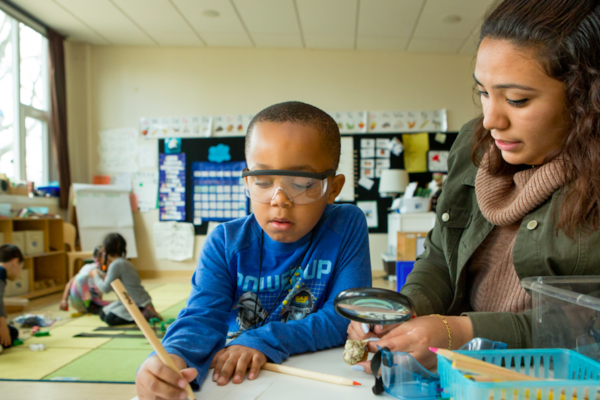When the District of Columbia’s city councilors handed 36-year-old Mayor Adrian Fenty control of the city’s public schools in 2007, they were hoping for salvation. Or maybe just absolution.
The city’s elected school board had been running a school system whose leadership didn’t know how many students attended school from day to day. New hires didn’t get paid for months. New textbooks gathered dust in warehouses while there weren’t enough to go around in classrooms. Elementary schools didn’t teach art or music, and high school electives were rare. The system was losing students to charter schools at a rapid clip.
Low pay made it hard for teachers to live in the city and forced many to take second jobs. And, in the absence of a common curriculum and citywide teaching standards, teachers were never sure what or how to teach. Test scores lagged far below the national average, and while more than 90 percent of the city’s students performed below grade level, 95 percent of teachers earned satisfactory ratings.
The day after Fenty won control of D.C.’s schools, he appointed Michelle Rhee, then-president of The New Teacher Project, as chancellor. She was the school system’s seventh leader in a decade.
Many of Rhee’s critics saw her as a tough-talking but inexperienced outsider, an ingénue with an attitude. They also charged that education reform in D.C. began and ended with Rhee’s determined effort to remove underperforming teachers from the city’s classrooms. Neither aspersion is true.
Rhee knew Washington’s schools well. She had worked with school officials for nearly a decade as the founder of the New Teacher Project, an organization conceived by Teach for America’s Wendy Kopp to help urban school systems recruit talented teachers outside of the traditional education-school pipeline.
While Rhee’s crusade to strengthen teaching during her three years as chancellor landed her on the cover of Time with a broom in her hand and a hard look on her face, she and her longtime colleague and eventual successor Kaya Henderson did far more than sweep out underperformers. They introduced a robust set of teacher reforms, transforming the occupation into a performance-based profession that gives teachers responsibility, recognition, collegiality, support, and significant compensation.
[Read More: A Policymaker’s Playbook for Transforming Teaching]
Rhee and Henderson did the same for principals—and much more. They revamped the way teachers teach, expanded pre-schooling, transformed the district’s central office into an engine of school improvement, rebuilt nearly half the city’s traditional public schools, and introduced rigorous achievement standards, as well as a new curriculum and new instructional materials.
Since 2012, new leadership at the District of Columbia Public Charter School Board has further strengthened the quality of the city’s expanding charter-school sector. Acting on a belief that rigorous oversight is critical, the board’s director has taken charter authorizing seriously, increasing student achievement even as charter enrollment has expanded to 47 percent of Washington’s public-school population since the mid-1990s.
The two sectors have collaborated to permit the city’s 93,000 public-school students to select traditional public schools and charters through a single, centralized application system that matches as many students as possible to their top choices while allowing families to make apples-to-apples comparisons through a universal school-rating system. Today, only 27 percent of students attend neighborhood schools.
These changes represent a dramatic transformation of urban public education that has translated into higher-quality teachers, more learning, and increasing enrollment in public-school classrooms. Student proficiency levels have increased on national assessments, and high-school graduations rates have climbed.
The improving results and growing number of easy-to-navigate educational options have increased parents’ confidence, even among the well-educated, middle-class families who had abandoned public schools in the past. Citywide public-school enrollment has risen to 93,000 from 71,000 over the past decade, including steady increases in D.C. Public Schools enrollment since 2009, with the school district adding more students than the charter sector in 2018–19 for the first time.
In fiscal year 2017, the District of Columbia spent $21,974 per pupil, the second-highest spending in the nation as measured against states, according to the U.S. Census Bureau’s Annual Survey of School System Finances.
Despite the presence of a federally funded private-school voucher program, the percentage of students in public schools increased to 88 percent in 2016, from an estimated 82 percent in 2005, according to data compiled by the mayor’s office.
To be sure, significant challenges remain. Though school quality has improved overall, weak schools persist, as do substantial achievement gaps between white students and their African American and Latinx counterparts. These gaps have closed slightly in reading but have increased in math, even as the performance of every racial group has improved. Despite extensive school choice, many students attend racially isolated schools, and half of the city’s white students attend private schools.
Still, the public-education infrastructure in the nation’s capital is far stronger today than it was in 2007. The reforms of the past decade have transformed public education in D.C. from a traditional, single-delivery model to a competitive, performance-based educational ecosystem—providing a promising new example of urban school reform.
Read the full article in Education Next here.

